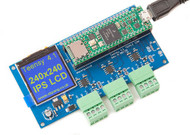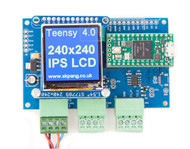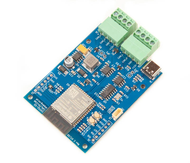Product Description
Free Shipping Within the United States!
This board is fitted with the ESPRESSIF ESP32‑S3‑WROOM‑1U‑N16R8 module:
-
Built around a dual-core Xtensa® LX7 CPU clocked up to 240 MHz, supporting single‑precision FPU and dedicated instruction extensions for machine learning and signal processing workloads.
-
Integrated co‑processors: an ultra‑low‑power RISC‑V RV32IMC ULP core and an FSM coprocessor for power‑efficient sensor monitoring.
-
Memory configuration: 16 MB Quad‑SPI Flash, 8 MB PSRAM (Octal SPI), 512 KiB SRAM, 384 KiB ROM, plus 16 KiB RTC SRAM.
-
Rich peripheral set: up to 45 GPIOs, 2 × 12‑bit SAR ADCs (up to 20 channels), I²C, SPI, I²S, UART, SD/MMC, USB OTG, remote control, PWM, touch sensor, temperature sensor, DMA, LED PWM, and notably a TWAI® controller (classic CAN compatible).
Wireless (Wi‑Fi + Bluetooth)
-
Supports Wi‑Fi 2.4 GHz (IEEE 802.11 b/g/n) at up to ~150 Mbps, with transmit power up to ~20 dBm and receive sensitivity around –103.5 dBm.
-
Bluetooth provided is Bluetooth v5.0 BLE—the WROOM‑1U variant does not include Bluetooth Classic (BR/EDR) unless the board adds external radio support; the reference module supports only BLE alongside Wi‑Fi.
Note: Your board statement says “Bluetooth Classic and BLE via external antenna” — be aware that the ESP32‑S3 SoC supports Bluetooth Low Energy, not Classic EDR. Unless there’s an external Bluetooth Classic transceiver, you most likely have BLE only.
-
Because of the U.FL (IPEX/MHF) connector, this module requires an external 2.4 GHz antenna (not included). It’s recommended to use a 50 Ω antenna with maximum gain ~2.33 dBi (as used in certification tests) to ensure compliance with RF and EMC standards.
CAN and CAN FD Interfaces
Classical CAN (CAN 2.0B)
-
Provided natively by the ESP32‑S3’s TWAI® controller mapped to pins on connector J7 (Classic CAN interface compliant with ISO 11898‑1).
CAN FD (Flexible Data‑Rate)
-
A separate MCP2518FD chip is used to provide CAN FD on connector J6, interfaced via SPI.
-
The MCP2518FD is a stand-alone external CAN FD controller supporting both classical CAN 2.0B (arbitration up to 1 Mbps) and CAN FD data rates (up to 8 Mbps), fully compliant with ISO 11898‑1:2015.
-
It offers advanced features: low‑power mode (~10 µA standby), up to 31 flexible FIFOs, multiple filters, and extended SEQ field capacity for event tracking.
Display & Touchscreen
-
A 5″ 480 × 854 IPS LCD with capacitive touch is mounted on the board.
-
The resolution matches a typical FWVGA portrait format, offering good sharpness and contrast for UI or instrumentation panels.
Features
- ESP32-S3 series of SoCs embedded, Xtensa® dual-core 32-bit LX7 microprocessor (with single precision FPU), up to 240 MHz
- 16MB Quad SPI flash
- 8MB PSRAM
- Bluetooth LE, Bluetooth 5 and Bluetooth mesh, requires external antenna
- Wifi 802.11b/g/n, requires external antenna
- Programming via USB-C connector
- Boot and Reset push button
- MCP2518FD CAN FD controller and CAN transceiver (J6)
- Classic CAN transceiver (J7)
- I2C connector for sensors
- Supply voltage : 7v to 24v SMPS module with reverse polarity protection
- Red LED on GPIO03
- IPS LCD Panel
- 480x854 pixels
- Panel dimension : 66.40(W)x120.05(H)x2.0(T)mm
- Visual Area : 62.56x110.53mm
- Active Area : 61.56(W)x109.53(H)mm
- Viewing Angle : Left:80.0 , Right:80.0 , Up:80.0 , Down:80.0 degree
- Brightness(Typ) : 360cd/m2
- Capacitive Touch controller GT911 with I2C interface
Documents
Ensure to select:
- Board:ESP32S3 Dev Module
- USB CDC On Boot "Enabled"
- PSRAM: "OPI PSRAM"
- Upload Mode: "USB-TG CDC (Tiny USB)"
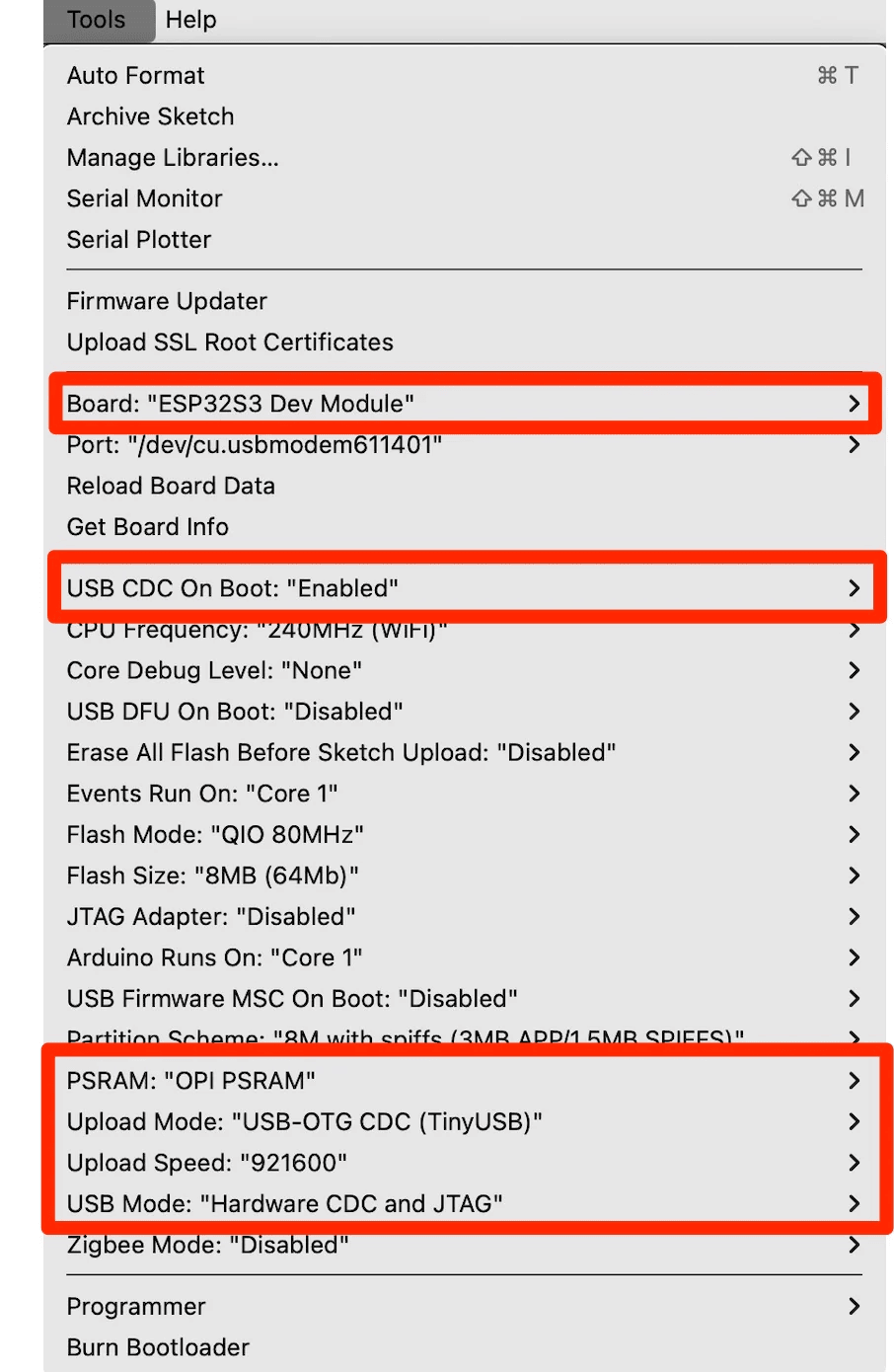
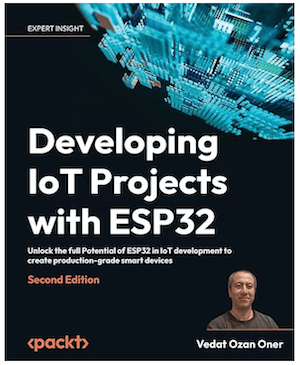 ESP32, the low-cost, energy-efficient system-on-a-chip (SoC) microcontroller, has become a cornerstone of modern Wi-Fi-enabled devices, driving innovation across the Internet of Things (IoT) landscape. This comprehensive guide offers a practical, end-to-end approach to building secure, scalable IoT systems using the powerful ESP32 platform.
ESP32, the low-cost, energy-efficient system-on-a-chip (SoC) microcontroller, has become a cornerstone of modern Wi-Fi-enabled devices, driving innovation across the Internet of Things (IoT) landscape. This comprehensive guide offers a practical, end-to-end approach to building secure, scalable IoT systems using the powerful ESP32 platform.
From foundational concepts to advanced implementation, the book walks you through the complete lifecycle of developing an IoT device with ESP32. Beginning with essential IoT principles and real-world use cases, each chapter progressively builds your skills—covering sensor communication, integration of key libraries like LittleFS and LVGL, Wi-Fi connectivity, data security, and cloud integration. You'll also learn how to visualize real-time data using tools like Grafana, making your solutions truly production-ready.
A special section is dedicated to artificial intelligence and machine learning (AI/ML) for embedded systems. You'll explore how to build and deploy tinyML models on the ESP32-S3, enabling intelligent edge computing capabilities for your next-generation embedded products.
Adopting a hands-on, project-driven approach, the book ensures that you can apply your knowledge from day one. As a capstone, you'll develop a full-scale Smart Home system, consolidating all the concepts and technologies explored throughout the book.
Whether you're a maker, engineer, or embedded systems developer, this book equips you to build secure, real-world IoT solutions with ESP32—ready for deployment in today’s connected world. More information...
 Loading... Please wait...
Loading... Please wait...




